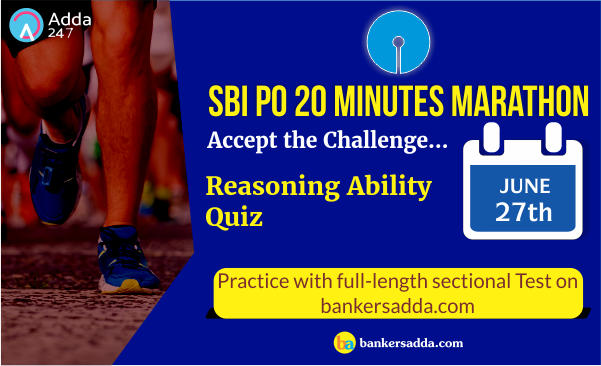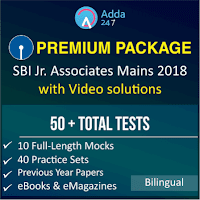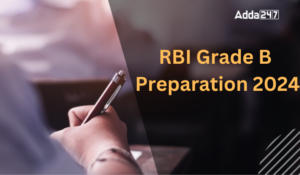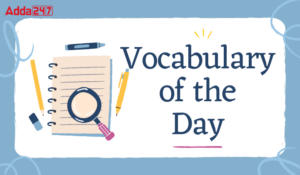Reasoning Ability Sectional Test: 27th June 2018
Directions (1-5): In the following questions, the symbols @, ©, # $ and % are used with the following meanings.
‘P @ Q’ means ‘P is neither smaller than nor equal to Q’.
‘P © Q’ means ‘P is not greater than Q’.
‘P # Q’ means ‘P is neither greater than nor equal to Q’.
‘P $ Q’ means ‘P is neither greater than nor smaller than Q’.
‘P % Q’ means ‘P is not smaller than Q’.
Now, in each of the following questions assuming the given statements to be true, find which of the three conclusions I, II and III given below them is/are definitely true and mark your answer accordingly.
Q1. Statements:
A @ C, B # C, B % D
Conclusions:
I. B © A
II. C % D
III. A @ D
II. C % D (Not True)
III. A @ D (True)
Q2. Statements:
L © M, M $ R, R # T
Conclusions:
I. L # T
II. T @ M
III. R % L
II. T @ M (True)
III. R % L (True)
Q3. Statements:
P @ Q, Q % R, R # S
Conclusions:
I. S $ Q
II. S # Q
III. S % Q
II. S # Q (Not True)
III. S % Q (Not True)
Q4. Statements:
M # N, N © P, O @ P
Conclusions:
I. M # P
II. O % N
III. O @ M
II. O % N (Not True)
III. O @ M (True)
Q5. Statements:
E © F, F $ L, L # K
Conclusions:
I. L % E
II. K # E
III. E # L
II. K # E (Not True)
III. E # L (Not True)
Directions (6-10): Read the following information carefully to answer the questions given below.
Seven Persons M, N, O, P, Q, R and S who all are staying in a seven storey building but not necessarily in the same order. The lowermost floor of the building is numbered 1, and the topmost floor is numbered 7. They all belongs to different states i.e. Haryana, Madhya Pradesh, Telangana, UP, Maharashtra, Rajasthan and Punjab but not necessarily in the same order. More than three persons lives above O. Only one person lives between O and P. Only three persons lives between the one who belongs to Madhya Pradesh and the one who belongs to Punjab, who lives on an odd numbered floor but below the one who belongs to Madhya Pradesh. O does not belong to Punjab. M belongs to Up and lives on the topmost floor of the building. More than three persons lives between M and the one who belongs to Rajasthan. Only one person lives between Q and R, who belongs to Telangana. P does not belong to Madhya Pradesh. The one who belongs to Haryana lives on one of the floor above the one who belongs Maharashtra but not immediately above. Neither P nor R belongs to Maharashtra. N lives on one of the odd numbered floor above S.
Q6. Who among the following lives immediately below the one who belongs to Rajasthan?
Q7. Who among the following belongs to Haryana?
Q8. Who among the following lives on the 5th floor?
Q9. Who among the following belongs to Maharashtra?
Q10. Who among the following lives on 2nd Floor?
Directions (11-15): Study the following information carefully to answer the given questions.
A word and number arrangement machine when given an input line of words and numbers rearranges them following a particular rule in each step. The following is an illustration of input and rearrangement.
Input: Automobile Education without Vowel off 9 42 15 72 3.
Step I: off 9 Automobile Education without Vowel 9 42 15 72.
Step II: off 9 Vowel 27 Automobile Education without 42 15 72.
Step III: off 9 Vowel 27 without 45 Automobile Education 42 72.
Step IV: off 9 Vowel 27 without 45 Education 14 Automobile 72.
Step V: off 9 Vowel 27 without 45 Education 14 Automobile 24.
Step V, is the last step
Input: Auriferous Mensuration Tambouri Author Motto 5 24 11 84 102.
Q11. Which of the following will be the penultimate step?
(11-15)
Numbers are arranged in increasing order from the left end. If the number is an odd number, then it is multiplied by three as it is arranged. Otherwise it is divided by three as it is arranged.
Input: Auriferous Mensuration Tambouri Author Motto 5 24 11 84 102.
Step 1: Motto 15 Auriferous Mensuration Tambouri Author 24 11 84 102.
Step 2: Motto 15 Author 33 Auriferous Mensuration Tambouri 24 84 102.
Step 3: Motto 15 Author 33 Tambouri 8 Auriferous Mensuration 84 102.
Step 4: Motto 15 Author 33 Tambouri 8 Mensuration 28 Auriferous 102.
Step5: Motto 15 Author 33 Tambouri 8 Mensuration 28 Auriferous 34.
Q12. Which of the following will be sixth from the right end in third step?
Q13. Which word/number would be second from the right end in Step IV?
Q14. After how many steps no further rearrangement of words is possible?
Q15. Which of the following will be the step IV?
Directions (16-20): Study the information and answer the following questions:
In a certain code language
"party said this might" is coded as " B#6 H@5 G@5 G#6 "
"bill has been passed" is coded as " O@5 H#4 M@5 H@7 "
"more and six girl" is coded as " I@5 M#4 C#4 I@5 "
Q16. What is the code for ‘supported'?
(16-20)
Q17. What is the code for ‘asking'?
Q18. What is the code for ‘select'?
Q19. What is the code for ‘certain'?
Q20. What is the code for ‘remain'?
Directions (21-25): Each of the questions below consists of a question and two statements numbered I and II given below it. You have to decide whether the data provided in the statements are sufficient to answer the question. Read both the statements and give answer
Q21. There are five persons A, B, C, D and E sitting in a circle facing towards outside. Who is on the immediate right of D?
I. B sits 2nd to the right of A. C sits third to the right of D
II. C sits between B and A.
Q22. What is the shortest distance between two points `M' and `N’?
I. ‘M’ is 5 m North from point ' S', which is to the west of ‘N’ at a distance of 4 m.
II. A point 'R' is in the West of ‘N' at a distance of 6 m and to the North of 'M' at a distance of 8 m.
Q23. Who is R's Brother?
I. M is son-in-law of A, who is married to B. B is the mother of R
II. M is the father of A. S is mother of R, and is married to M.
Q24. Who among the five friends A, B, C, D and E is the oldest?
I. E is older than three of them but A is younger than C.
II. B is older than D and E.
Q25. Who among the following is the shortest in height?
I. There are five student A, B, C, D and E in a class. A is taller than both B and D but not the tallest.
II. C is taller than A. E is shorter than B and D
Directions (26-30): Study the following information carefully and answer the questions given below:
Twelve people are sitting in two parallel rows containing six people each, in such a way that there is an equal distance between adjacent persons. In row–1 A, B, C, D, E and F are seated and all of them are facing South. In row-2 P, Q, R, S, T and V are seated and all of them are facing north. Therefore, in the given seating arrangement each member seated in a row faces another member of the other row.
P sits third to the left of T. Neither P nor T sits at an extreme end of the line. A sits second to the right of E. Neither A nor E faces T or P. A does not sit at an extreme end. R does not face A and R does not sit at an extreme end of the line. Only one person sits between F and C. Neither F nor C faces T. C does not sit at the extreme end. Only one person sits between V and Q. F is not an immediate neighbour of B . A does not face V.
Q26. How many people sit to the right of V?
Q27. V is related to B in the same way as Q is related to C. Which of the following is related to P, following the same pattern?
Q28. Which of the following is true regarding V?
Q29. Who among the following sit at extreme ends of the rows?
Q30. Who among the following faces B?
Directions (31-35): Read the following information carefully to answer the questions given below.
Eight friends M, N, O, P, Q, R, S and T are sitting around a circular table for dinner such that some of them are facing towards the centre of the table and some of them are facing outside the centre of the table. They all lives in the same apartment such that the ground floor is numbered 1 and above it second floor and so on till the topmost floor which is numbered 8. R does not faces outside of the centre. Q sits third to the right of P, who lives on an even number floor and both face same direction. The one who lives on eighth floor sits third to the left of P and 2nd to the right of the one who lives on 3rd floor. N and S faces same direction. R, who lives on fifth floor sits third to the right of N, who lives on an even numbered floor but not on 2nd or 6th floor. R is one of the neighbour of P and sits third to the right of M, who faces inside. Q does not live on third floor. The one who lives on 7th floor sits opposite to the one who lives on 6th floor. S sits second to the right of the one who lives on 1st floor. O lives on second floor and faces the same direction as R.
Q31. Who lives on the third floor?
Q32. Who among the following sits third to the right of O?
Q33. M lives on which of the following floor?
Q34. Who among the following lives on 1st Floor?
Q35. How many persons sit between S and the one who lives on 5th Floor?
- IBPS RRB Notification Out: Check Official Notification
- Stand Your Ground Till You Do Not Make It Happen
- Syllabus for IBPS RRB 2018 Exam
- IBPS RRB 2018 Preparation Strategy: Get Started!




 The Hindu Review October 2022: Download ...
The Hindu Review October 2022: Download ...
 RBI Grade B Preparation 2024: Ultimate P...
RBI Grade B Preparation 2024: Ultimate P...
 Vocabulary of The Day- 18 April
Vocabulary of The Day- 18 April



